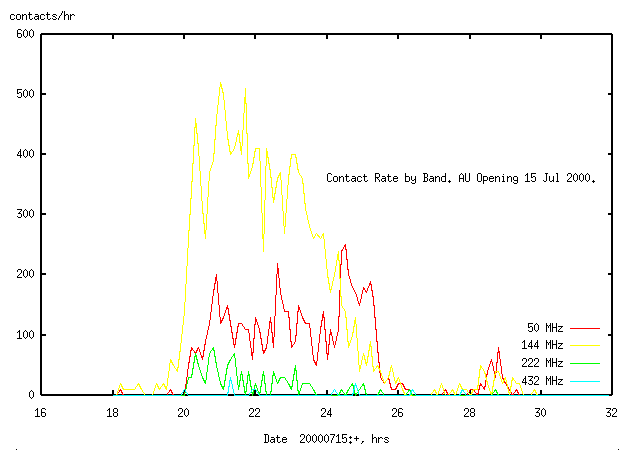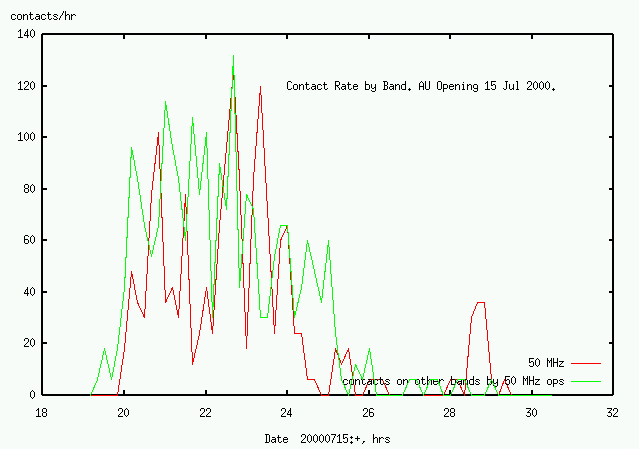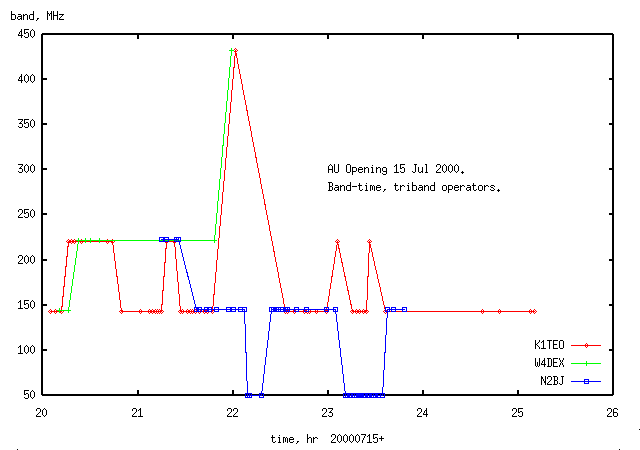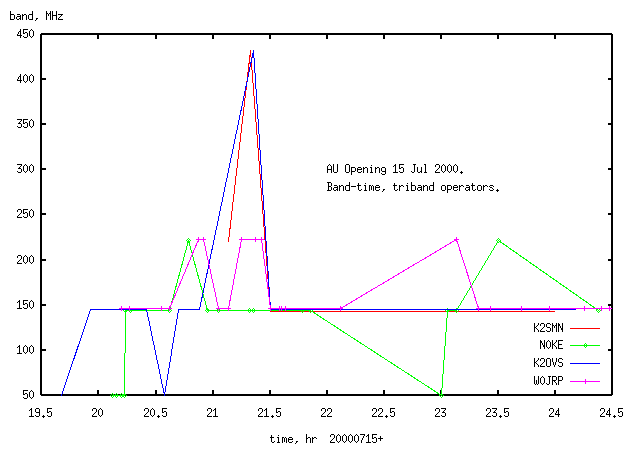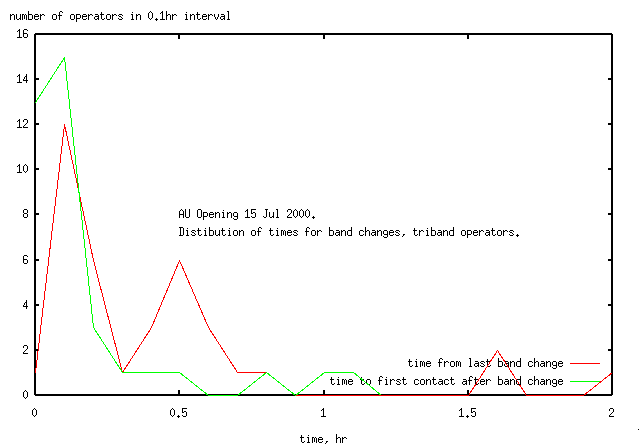

| bands | hams | contacts | contacts/op |
|---|---|---|---|
| 1 | 609 | 1453 | 2.4 |
| 2 | 114 | 941 | 8.3 |
| 3 | 14 | 202 | 14.4 |
| 4 | 0 | 0 | 0 |
Almost half of the contacts were made by multiband operators who comprised 17% of the participants, ie multiband operators had a higher contact rate than other operators. Presumably having multiband capability is a liability as far as contacts/operator go, since the number of people available to make contacts on 222MHz and 432MHz is lower than at 50MHz or 144MHz. Presumably the numbers are biased towards multiband operators as
The ARRL has noticed these experienced, better equipped, older, mostly college educated and financially established people in ham radio. Such a group of people have not been available before in ham radio and has enabled such programs as club sponsored courses for ham licenses and the VE program. The ARRL's reaction to this pool of older people, (and I'm not making this up), is to regard the presence of large numbers of older hams as a problem, and blame them for the drop in ARRL membership. The ARRL's solution is to restructure ham radio, to devalue the Extra license to a Technician level, so that cash-strapped non-technical teenagers for new members will seek out the ARRL to send it money in the form of memberships.
An opening (by definition) is short. In a big opening, a multiband operator finding conditions good on lower bands will be encouraged to move to higher bands, but has to balance the lower probability of success at higher bands and complexity of changing bands, against the certainty of more contacts by staying where they are. In contests, one strategy is to sit on lower bands and "run bands" (ask the other operator for higher bands). If they get a match, they QSY with their antennas already lined up on the other ham, and after making contact on the higher bands, return to the original band.
I looked for 2 things:
Here's the contact rate by band again.
I wondered if people
started off on 6m and then went to higher bands. I looked for
the people who worked on 6m at any time in the opening and
graphed their activity on other bands. Here's the result
from a preliminary analysis when I only had logs for 1500 contacts.
If multiband capable 6m operators moved off 6m when they
found 2m and above open, I would expect that their activity
on 6m would drop and activity on other bands would go up.
The results show that activity on the other bands was constant throughout
the opening, indicating that 6m people didn't change bands
as a function of time through the opening.
I then looked at the tri-band operators to see how
they made their contacts.
14 operators made contacts on 3 bands, making 202 contacts.
Logs were submitted from 8 of these operators:
K1TEO, K2SMN, N2BJ, W4DEX, K2OVS, N0KE, W0JRP, (KB8U not plotted, ran out of time).
The band on which each operator made contacts is plotted
against time. The data is split into 2 graphs for readability.
Each point is a contact on a band.
The graphs show only contacts - it is possible that the operators
are listening on other bands in between contacts.
In the first graph both K1TEO and W4DEX are simultaneously on 432.
They are not having a contact with each other; both are contacting another person.
In this 2nd graph, K2OVS and K2SMN are working each other on 432.
To see if operators "ran bands"
I looked in each log to see if the ham worked after a band change
had just been worked on a lower band. For 7 of the 8 logs
(K1TEO, W4DEX, N2BJ, K2SMN, K2OVS, W0JRP, KB8U) the hams worked
after a bandchange were all new calls.
Only N0KE (on CW) re-worked 3 stations within 10minutes following an upband change.
2 of these stations were consecutive contacts on 2 bands indicating that they
were "running bands".
The band change was from 6m to 2m with path distances of 300-600km.
W3ZZ (unsuccessfully) tried to get W7XU to move up with him from 2m to 222.
W4MW tried (unsuccessfully) for a 903MHz contact.
No-one successfully arranged contacts
on 222 or 432 from QSOs on lower bands.
None of these operators worked multiple bands simultaneously, they
stay on one band for long periods and then change to another band
and stay there for a while.
Apparently running bands doesn't work (or isn't tried) on AU.
Some operators sit on a band for quite some time
without making a contact.
W0JRP appears to have moved from 2m to 222 at 2200 and
didn't get a contact for an hour and then moved back immediatedly to 2m.
K1TEO waits for an hour after his 432 contact before returning to 2m.
There were 37 band changes amongst 7 operators spread out over
5hrs, or 1 change/hr for each operator.
Here is the distribution of
time spent on a new band before getting a contact
(measured by the time since the last contact on the previous band)
and the
time between band changes bands (measured by time since first
contact on the previous band).
The most frequent interval for getting a contact after changing bands
is 0.1-0.2hr.
(C) Joseph Mack 2000-2002, Joe NA3T jmack (at) wm7d (dot) net, http://www.wm7d.net/azproj.shtml
Previous
Next
Table of Contents
